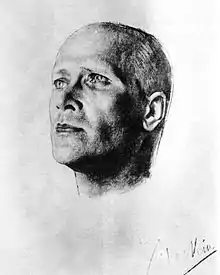Joseph Hackin
Joseph Hackin (born 1886 in Boevange-sur-Attert (Luxembourg); died 24 February 1941) was a French archeologist and Resistance member.

Biography
Born in Luxembourg, he was graduated from the Ecole libre des sciences politiques and of the École des langues orientales, Paris. He acquired the French nationality in 1912. Initially, he was an assistant curator of the Musée Guimet and became later the curator.
In 1931, he participated in the Yellow Expedition.[1] After several archeological missions in Afghanistan, he was appointed director of the Délégation archéologique française en Afghanistan in 1934.
During the excavations conducted by Hackin and his team in Begram, between 1937 and 1940, an exceptional treasure of the Kushan period (1st–2nd century A.D.) was unearthed. It included a large number of Roman bronze, alabaster, Syrian glass, coins, Chinese lacquer bowls, and the famous "Begram ivories".[2]
In October 1940, with his wife, Marie Hackin, he joined the Free French Forces in London. He was appointed as the personal representative of the General de Gaulle in India and surrounding countries. But he perished with his wife when their transport ship, "Jonathan Holt", was sunk by a German torpedo near the Faroe Island, 24 February 1941.[3]
Decorations
- Croix de Guerre 1914-1918
- Chevalier de la Légion d'Honneur
- Compagnon de la Libération
References
- Georges Le Fèvre: La Croisière jaune: Expédition Citroën Centre-Asie, Paris 2020, p. 332. Available here.
- Gilles Rossignol, in preface to René Dollot, Afghanistan 1934–1936, Paris, Ceredaf, 2017, pp. 21–22.
- Exhibition : De l’Asie à la France libre. Joseph et Marie Hackin, archéologues et compagnons de la Libération, Paris, 15 June–16 September 2018 (Musée de l’Ordre de la Libération, Musée de l’Armée, Musée national des arts asiatiques-Guimet).